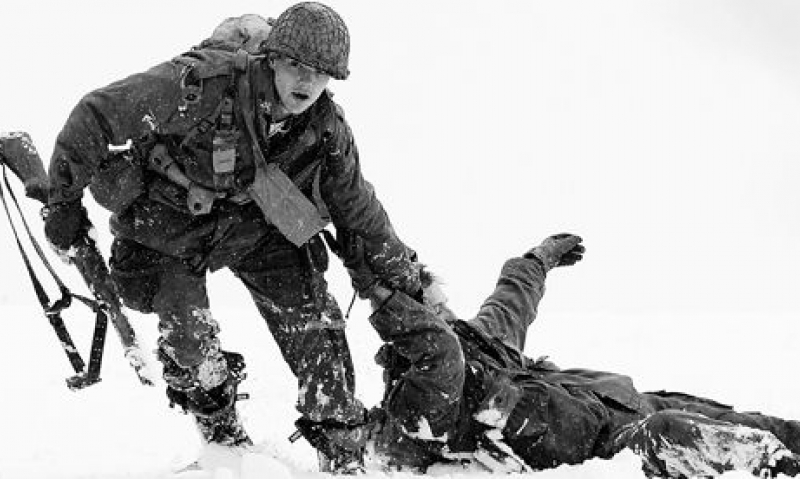
The 90-minute documentary discusses the largest land battle ever fought by the U.S. Army: the Battle of the Bulge.
“The Americans in the Bulge,” a 90-minute documentary about the largest land battle ever fought by the U.S. Army, is the final installment of the World War II combat trilogy, “The American Road to Victory,” produced by Atlanta-based WW2 Reflections.
During the documentary, historian Ellwood von Seibold takes viewers on an inspired journey among the forests, fields, towns and fortifications where the Battle of the Bulge erupted in December 1944 between Allied and German forces. Carrying an M-1 rifle and appearing in a variety of uniforms from both sides, Seibold reprises his role as the energetic battlefield guide who runs, leaps, crawls and fires a bazooka as he re-enacts courageous efforts by American soldiers and explains their significance.
“This is a story of bitter cold, merciless fighting, instances of extreme bravery and cunning, and the largest and most costly intelligence blunder since Pearl Harbor,” Seibold says as he stands in front of a snow-covered landscape.
And so it was. Just when many Allied leaders thought the German Army was on the verge of collapse, Adolf Hitler managed to assemble three large armies under cover of the fog and mist that surrounded the Belgian-German border.
Trudging through the snow, Seibold explains that American units with little or no combat experience were strung across a 70-mile front alongside the edge of the Ardennes Forest in Belgium. Things had been quiet on this “Ghost Front,” but the great, white expanse sometimes played tricks on soldiers’ eyes. “If you look at a snow bank long enough, it will move,” says John Kline, a veteran of the 106th Infantry Division and one of many veteran narrators in the film.
At 5:30 a.m. on Dec. 16, 1944, the Germans launched an intense artillery and rocket barrage against American forces, then crashed over the Belgian border with three armies: the Fifth, Seventh and Sixth SS Panzer – 300,000 combat troops, 2,000 artillery pieces and 700 heavy tanks (including 70 of the formidable “Tiger II” tanks with six-inch armor plating).
Seibold says the Germans also sent over a special commando brigade, led by SS officer Otto Skorzeny. The brigade would commit acts of sabotage and confuse American troops throughout the battle by wearing U.S. uniforms and driving U.S. vehicles.
The mid-winter onslaught by an enemy supposed to be all-but-kaput took American troops by surprise. With the Sixth SS Panzer spearheading the attack, the Germans smashed through the front lines and raced toward the Meuse River. Hitler planned to capture the Dutch port of Antwerp, split U.S. and British forces in the region, and create such chaos that the Allies would sign peace terms favorable to the Third Reich.
That was the plan, at least.
“The Americans in the Bulge” tells the tale of what really happened at the Battle of the Bulge with clarity and well-researched authority. Nearly out of breath at times, Seibold reveals the twists and turns of the battle in the places where they occurred, as he drives in a jeep, races across a field or hides behind a tree as an enemy tank rolls past. Well-crafted, animated maps help Seibold’s commentary along, clearly showing viewers the advance of German forces and their objectives.
Archival film footage is effectively intercut with outstanding reenactment video to weave a visually entertaining program – one that should be enjoyed by anyone with an interest in World War II.
For more information on “The Americans in the Bulge” and the trilogy’s other programs (“The Americans on D-Day” and “The Americans on Hell’s Highway”), visit the production company’s website at www.ww2-reflections.com.
- Library & Museum

